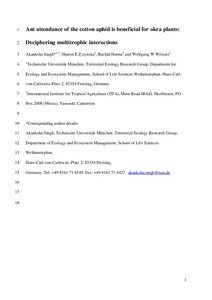| dc.contributor.author | Singh, A. |
| dc.contributor.author | Zytynska, S.E. |
| dc.contributor.author | Hanna, R. |
| dc.contributor.author | Weisser, W.W. |
| dc.date.accessioned | 2019-12-04T11:04:05Z |
| dc.date.available | 2019-12-04T11:04:05Z |
| dc.date.issued | 2016-08 |
| dc.identifier.citation | Singh, A., Zytynska, S.E., Hanna, R. & Weisser, W.W. (2016). Ant attendance of the cotton aphid is beneficial for okra plants: deciphering multitrophic interactions. Agricultural and Forest Entomology,16(3), 270–279. |
| dc.identifier.issn | 1461-9555 |
| dc.identifier.uri | https://hdl.handle.net/20.500.12478/1334 |
| dc.description | First published: 9 April 2016 |
| dc.description.abstract | Aphids are pest species of many crops and biocontrol methods are often ineffective. Ant–aphid associations can be mutualistic or antagonistic, with ants increasing or reducing aphid numbers. Within-species plant variation or other herbivores may further influence these ant–aphid interactions.
Okra is an economically important crop in Cameroon. Several okra varieties are grown here and attacked by the facultatively ant-tended cotton aphid Aphis gossypii. We conducted field and screenhouse experiments where plant variety, ant presence and predator access were manipulated to investigate the multitrophic interactions on okra and their effects on okra yield.
In the field, ants did not protect aphids from their natural enemies and syrphid larvae reduced aphids by 42%. Additionally, aphid recruitment of ants reduced chewing herbivore damage by 11% and indirectly increased okra fruit set. We also found aphid numbers, aphid predation by syrphids and chewing herbivory to vary across okra varieties. Finally, in the screenhouse, we recorded a 24% reduction in aphid numbers on plants with ant presence.
The present study highlights the importance of direct and indirect biotic interactions for pest biocontrol. Tropical agricultural systems are complex and understanding such interactions can help in designing pest control measures in sustainable agriculture. |
| dc.description.sponsorship | Federal Ministry for Economic Cooperation and Development, Germany |
| dc.format.extent | 270-279 |
| dc.language.iso | en |
| dc.subject | Biocontrol |
| dc.subject | Aphids |
| dc.subject | Pest Control |
| dc.subject | Okra |
| dc.subject | Ants |
| dc.title | Ant attendance of the cotton aphid is beneficial for okra plants: deciphering multitrophic interactions |
| dc.type | Journal Article |
| dc.description.version | Peer Review |
| cg.contributor.crp | Integrated Systems for the Humid Tropics |
| cg.contributor.affiliation | Technische Universität München |
| cg.contributor.affiliation | International Institute of Tropical Agriculture |
| cg.coverage.region | Africa |
| cg.coverage.region | Central Africa |
| cg.coverage.country | Cameroon |
| cg.isijournal | ISI Journal |
| cg.authorship.types | CGIAR and advanced research institute |
| cg.iitasubject | Pests Of Plants |
| cg.journal | Agricultural and Forest Entomology |
| cg.howpublished | Formally Published |
| cg.accessibilitystatus | Limited Access |
| local.dspaceid | 79266 |
| cg.targetaudience | Scientists |
| cg.identifier.doi | https://dx.doi.org/10.1111/afe.12159 |

